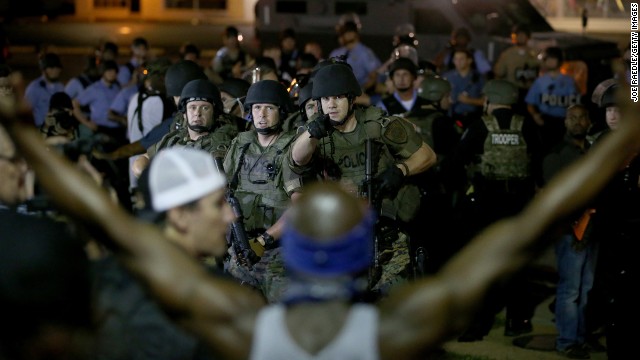Ferguson Cops Kill A Second African-American Youth, Protests Continue
Police point out a demonstrator who has his arms raised before moving in to arrest him
NEW DELHI: Protests in the St. Louis suburb of Ferguson, Missouri, which began in response to a police shooting of 18 year old African-American Michael Brown, have been impacted by a second shooting. On August 19, exactly ten days after Brown was shot in broad daylight by a police officer, 25 year old Kajieme Powell, also African-American, was shot by another police officer on the north side of St. Louis.
Although Brown was reportedly killed as he was walking, unarmed, from a convenience store to his grandmother’s apartment in Ferguson, Powell, police say, was robbing a convenience store and brandishing a knife. Nevertheless, the killing has given a spurt to the protests in Ferguson, refocusing attention on the reality of racial discrimination, police brutality, and the absence of civil rights in a deeply unequal United States.
Ferguson, which has recently emerged from a curfew after the National Guard was moved in, has come to resemble a war zone, depicting heavily armed riot police and scores of protesters. The local police has come under attack for the shooting of the unarmed teenager, and the brutality with which it has curbed largely peaceful protests, thereafter.
At the time of writing, news broke that a police officer, who had threatened to kill protesters as he pointed his gun at them, had been indefinitely suspended. Video captured showed the officer threatening, “I will f---ing kill you.”
As thousands of people took the streets to ask for justice, personal accounts of people feeling targeted by the police on the basis of their race began emerging. The incident, seems to be a trigger, representing years of frustration and marginalisation. Ferguson is a city of 21,000 people - 67 percent of whom are black. However, 94 percent of the police force, and most prominent figures in local government, including the mayor, are white.
The situation prompted a statement from US President Barack Obama, who on Monday, whilst acknowledging deep racial divisions in American society, appealed for calm. “In too many communities around the country, a gulf of mistrust exists between local residents and law enforcement… In too many communities, too many young men of color are left behind and seen only as objects of fear,” Obama said, adding that whilst progress has been made, “we have not made enough progress.”
Whilst stating that there was “no excuse for excessive force by police or any action that denies people the right to protest peacefully,” Obama said, “I understand the passions and the anger that arise over the death of Michael Brown, [however] giving in to that anger by looting or carrying guns and even attacking the police only serves to raise tensions and stir chaos.”
At the time of writing, the situation remained tense in Ferguson, with protests continuing. The shooting of Michael Brown is being compared to the shooting of 17-year old unarmed Trayvon Martin, who was killed by a neighbourhood watch captain. The shooter was eventually acquitted of murder in a racially charged case.
Other parallels have been drawn as well. The killing of 17-year old Jordan Davis, who was, along with his friends, shot at by a man for playing “loud music.” The jury convicted the shooter on four counts, but not on the count of murder, with many attributing the verdict to a racial context -- the shooter being white and the teenagers, including Davis who died, being black.
The most apparent parallel however, are the Los Angeles riots of 1992 -- where the trigger was the brutal police beating of Rodney King, which was videotaped and widely covered but ended in the acquittal of the officers concerned. The Ferguson protests, much like the LA riots of 1992, may have been a reaction to an immediate trigger, but are located in a far broader context of marginalisation and discrimination.





